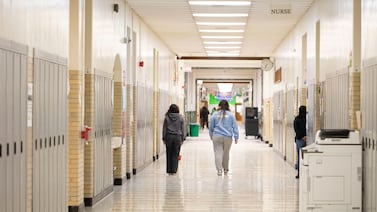Sign up for Chalkbeat Colorado’s free daily newsletter to get the latest reporting from us, plus curated news from other Colorado outlets, delivered to your inbox.
The percentage of Colorado students who are chronically absent dropped for a second year, a promising sign that schools may be getting more kids engaged in classes.
State data for the 2023-24 school year, released by the Colorado Department of Education Thursday, showed that 27.7% of students were chronically absent, down 3.4 percentage points from a year before. In raw numbers, 241,119 Colorado students — more than 1 in 4 — were chronically absent last school year, meaning they missed more than 10% of school days.
The rate of chronic absenteeism is still higher than it was in the 2019-20 school year, before the pandemic, when 22.6% of students were chronically absent. According to a news release from the state, the 2023-24 rate is the third-highest rate since data collection began in 2016.
And now the state has set a goal to decrease the percentage of chronically absent students to 17.8% by the 2026-27 school year.
“We know that our educators and school leaders are working urgently to keep students engaged and feeling connected to their school communities, and we see that effort reflected in attendance and chronic absentee rates,” Susana Cordova, state education commissioner, said in a news release. “If students aren’t in school, we know they won’t have access to the opportunities designed to help them continue learning.”
Students who are chronically absent are less likely to learn to read on grade level by third grade, and more likely to eventually drop out of school. Even excused absences count toward chronic absenteeism, and just a few absences a month can add up to 10% of school days.
Schools across the country are dealing with the same struggle to improve attendance. A recent survey of states by the independent think tank FutureEd showed Colorado in the middle of the pack, with lower rates than some, but higher rates than others.
And while all groups of students made improvement, gaps remain because some groups of students are chronically absent more than others. Students who are experiencing homelessness, those who come from low income families, and Hispanic students have some of the highest rates.
Pacific Islander students had the highest rate of chronic absenteeism at 50.1% in the most recent school year. Pacific Islander students also had some of the smallest decreases in chronic absenteeism year over year.
Students who are experiencing homelessness had a 56% chronic absenteeism rate, down from 59.5% in 2022-23.
Hispanic students had a 37.1% chronic absenteeism rate in 2023-24, down from 41.4% in 2022-23.
A majority of school districts saw improvement in reducing chronic absenteeism rates. Colorado Springs District 11, District 49, Roaring Fork, and Englewood had some of the bigger decreases.
The state highlighted the districts of Durango and Alamosa as two places that had big improvements. In Alamosa, state officials said that the district had the support of the community in its campaign and had coffee shops putting stickers on cups to remind families that every day in school mattered.
Making significant improvements to attendance does require everyone to be involved, officials said.
Thirty percent of districts had a higher chronic absenteeism than a year before, including the Sheridan, Adams 14, Elizabeth, and Eagle school districts.
In Denver, the state’s largest district, chronic absenteeism was 37.1% in 2023-24, down from 41.1% the prior year.
State officials say that based on what they’ve heard anecdotally, challenges related to reliable transportation, illness, and feeling unsafe in school have worsened in some places over time, contributing to attendance problems.
The Colorado Department of Education announced a new initiative to help school districts get more students attending school. The work would include a guidebook for school and district leaders, a virtual resource hub, and training for educators.
Decreasing the amount of missed school is thought to be important in improving student achievement. State test results released earlier this week show progress in getting students to pre-pandemic achievement levels or better, but officials acknowledged more work remains to keep student results improving.
Yesenia Robles is a reporter for Chalkbeat Colorado covering K-12 school districts and multilingual education. Contact Yesenia at yrobles@chalkbeat.org.






